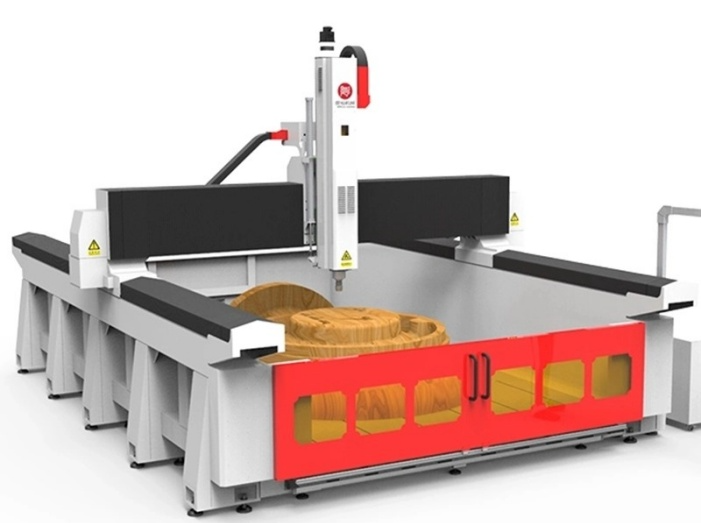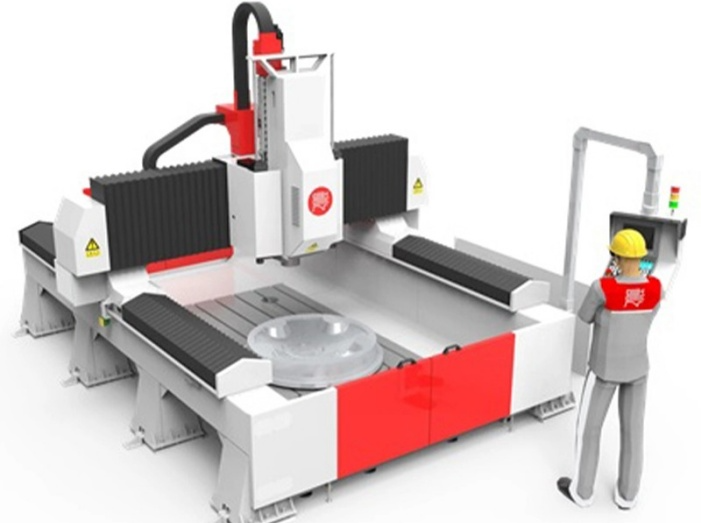If you’ve ever stuck with traditional mold making—spending hours on manual carving just to fix uneven edges, or switching between three machines to finish one large composite mold—you know how frustrating inefficiencies can get. CNC mold making changes that, but not every step needs it. And when you’re ready to pick equipment, CHENcan (a 27-year CNC expert from China) has tools built for non-metal molds—think wood, foam, GRG, and GRC. They’ve got two factories, ISO 9001 and CE marks, and even support 70+ countries.

What Traditional Mold Making Steps Face Efficiency Bottlenecks That CNC Can Solve?
You probably notice the slowdowns first: parts that take too long, mistakes that force redoes, or machines that can’t handle big jobs. Let’s look at the three most common pain points CNC fixes.
Manual Carving of Non-Metal Mold Blanks (Wood/Foam) Causes Low Precision and Slow Speed
Carving wood or foam blanks by hand sounds simple, but it’s not. Even skilled workers can’t keep every edge straight—you might end up with a mold that doesn’t fit the final product. And it’s slow: a medium foam blank could take 8 hours manually, but CNC cuts that time in half.
Traditional Drilling/Graving for Small Mold Details Leads to High Error Rates
Small holes or fine engravings? Traditional tools slip easily. You might drill 10 holes and have 2 that are off-center—wasting material and forcing you to start over. This gets worse with soft materials like styrofoam, which bends if you press too hard.
Large-Scale Composite Mold (GRG/GRC) Processing Relies on Multiple Machines and Long Cycles
GRG or GRC molds for buildings (like decorative columns) are big—sometimes 6 meters long. Traditional setups make you cut the base on one machine, shape the sides on another, and smooth edges on a third. Each move risks damaging the mold, and the whole process can take 3 days or more.
How Does CNC Mold Making Optimize the Non-Metal Mold Blank Processing Step?
Non-metal blanks (wood, foam, resin) are tricky—they’re soft but need sharp edges. CNC doesn’t just speed this up; it makes the process smoother, so you don’t waste blanks. Here’s how it works.
Wood Foam Resin CNC Router Enables One-Stop Processing of Wood/Foam Blanks
A router built for non-metals, like the Wood Foam Resin Grg Gpg Gfrc Grc molds Patterns Large Cnc Mold Making Router, handles everything in one go. Load a foam blank, set the design, and it cuts, shapes, and smooths without you moving the material. No more switching tools mid-job.
High-Precision Ball Screws and Linear Guides Ensure Blank Dimension Accuracy
Ball screws and linear guides are the parts that keep the CNC moving straight. They’re precise—down to 0.01mm—so every blank comes out the same size. You won’t have one foam mold that’s 2mm too short and another that’s too long.
Pneumatic Lubrication System Reduces Wear for Continuous Blank Processing
CNC runs for hours, so parts wear down fast without lubrication. A pneumatic system sprays oil automatically, so the machine keeps going. You can run 10 blanks back-to-back without stopping to oil parts—saves you at least an hour a day.
Which CNC Tools Optimize the Mold Detail Carving and Drilling Step?
Small details make or break a mold—like the tiny grooves in a foam pattern for a pump valve. CNC tools fix the slip-ups traditional methods cause, and they work fast even on soft materials.

3D Carving/Graving/Drilling CNC Router Completes Foam/Wood Molds in One Go
The CHENcan 3020 Metal Foam Wood Styrofoam 3D Carving Graving Drilling CNC Router Machine is perfect here. It carves 3D shapes, drills small holes, and even adds engravings—all with the same tool. For a wood mold with 5mm holes and a curved surface, it takes 2 hours instead of 5.
BT40-12000rpm Spindle Ensures Smooth Detail Cutting on Styrofoam
Styrofoam melts if the tool moves too slow. A 12,000rpm spindle spins fast enough to cut cleanly without melting edges. You get smooth grooves instead of ragged ones—no need to sand afterward.
12-Tool Magazine Reduces Tool Change Time for Multi-Detail Mold Processing
If your mold needs 3 different tools (one for carving, one for drilling, one for smoothing), a 12-tool magazine swaps them automatically. You don’t have to stop and change tools by hand—cuts tool change time from 5 minutes per swap to 30 seconds.
Can CNC Mold Making Optimize Large-Scale Composite Mold (GRG/GRC) Processing?
Large composite molds (like those for hotel lobbies or stadiums) are a nightmare with traditional tools—they’re heavy, hard to move, and easy to damage. CNC handles them better, and it cuts down the time you spend on setup.
Large CNC Mold Making Router Handles GRG/GRC Processing with 6000mm X-Axis Travel
A router with a 6-meter X-axis (like the large model from CHENcan) can handle full-size GRG columns in one piece. You don’t have to cut the mold into sections and glue them together—no more weak spots where sections meet.
Z-Axis Hydraulic Balance System Maintains Stability for Tall Composite Molds
Tall molds (3 meters or more) make the CNC’s Z-axis (the part that moves up and down) work hard. A hydraulic balance system keeps it steady, so the tool doesn’t dip or rise unexpectedly. You get even cuts across the whole mold.
Cabinet Cooling System Prevents Overheating During Long-Hour Composite Processing
GRG processing takes 4-6 hours straight. A cabinet cooling system keeps the CNC’s electronics cool, so it doesn’t shut down mid-job. You won’t have to restart a mold because the machine overheated—saves you a full day of work.
What Advantages Does CNC Equipment Bring to Mold Making Quality Control?
Quality control is a hassle when every mold is a little different. CNC makes it easier because it’s consistent—you get the same result every time, and you catch mistakes faster.
Huazhong Control System Ensures Consistent Processing Parameters
Huazhong systems store your design settings—speed, tool depth, cut width—so every mold uses the same parameters. You won’t have one mold cut at 800mm/min and another at 1000mm/min. Consistency means fewer rejects.
Laser Interferometer-Calibrated Axes Reduce Mold Size Deviation
Laser interferometers check the CNC’s axes to make sure they’re moving exactly as they should. They fix tiny deviations (like 0.005mm) that you can’t see by eye. Your molds will fit the final product every time—no more “close enough” parts.
Dustproof Design Protects Mold Surfaces from Contamination
Wood and foam dust gets everywhere. A dustproof design keeps dust off the mold surface, so you don’t have to clean it before use. For resin molds, this means no dust bubbles in the final product—saves you from redoing the mold.
Why Choose CNC Mold Making Equipment for Step Optimization?
You might wonder if CNC is worth the cost. The short answer: yes, because it saves you time and money in the long run, and it opens up new work you can’t do with traditional tools.
Long Experience in CNC R&D Ensures Reliable Mold Processing Performance
Company like CHENcan with decades of CNC experience knows what works. They’ve tested their tools on hundreds of molds, so you don’t have to deal with trial and error. Reliable machines mean fewer breakdowns and more time making molds.
ISO 9001 and CE Certifications Meet Global Mold Manufacturing Standards
If you sell molds to other countries, certifications matter. ISO 9001 means the equipment meets quality standards, and CE means it’s safe to use in Europe. You won’t have to turn down orders because your tools don’t meet global rules.
Global Distributors Ensure Timely After-Sales Service
Distributors in places like the US, India, and Russia mean you get parts fast. If a spindle breaks, you don’t wait 4 weeks for a part from China—you get it in 3 days. Timely service keeps your workflow moving.
FAQ
Q1: How much time can CNC save on non-metal mold blank processing?
A: It depends on the blank size, but usually 30% to 50%. A manual foam blank that takes 8 hours might take 4-5 hours with CNC. For large GRG molds, it can cut 2-3 days off the process.
Q2: Can CNC handle both small detail molds and large composite molds?
A: Yes, but you’ll need the right tool. Small detail work (like 5mm holes) works with a compact router, while large GRG molds need a router with a long X-axis (6 meters or more). Some brands offer both options.
Q3: Do I need a lot of training to use CNC for mold making?
A: No, most providers offer on-site training. Your team can learn the basics in 1-2 days, and remote support helps with tricky jobs. The control systems are user-friendly—you don’t need to be a tech expert.





